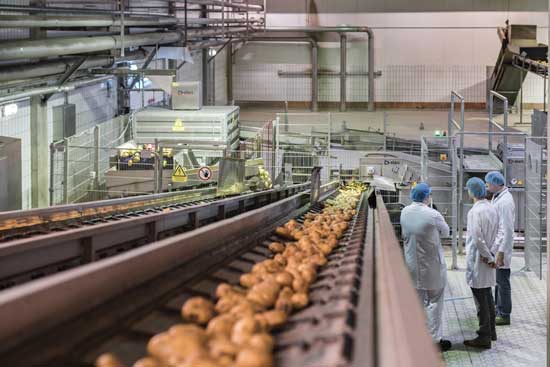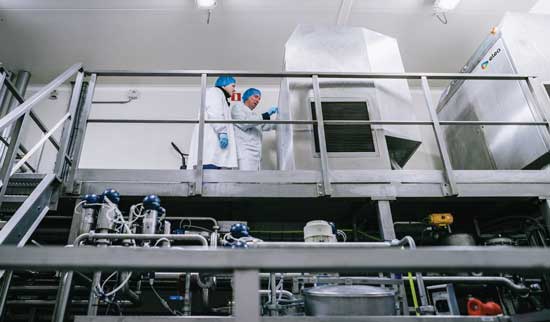Pulsed Electric Field Processing for Fruits and Vegetables
PROCESSING
This month’s column reviews the theory and current applications of pulsed electric field (PEF) processing for fruits and vegetables to improve their safety and quality. This month’s column coauthor, Stefan Toepfl, is advanced research manager at the German Institute of Food Technologies and professor of food process engineering at Osnabrueck University of Applied Sciences. He has been active in process and equipment design for PEF processing and as a stakeholder for the PEF equipment manufacturer Elea GmbH. Elea GmbH is one of several companies that have contributed toward the transfer of PEF processing technology from lab scale into industrial food processing.
The Basic Principles
Pulsed Electric Field processing is nonthermal and allows the targeted permeabilization of biological cell membranes. This effect, termed electroporation, results in release of intracellular substances and cell death. Pore formation occurs when, by an external electrical field, a transmembrane potential of approximately 1 V is induced. Dependent on treatment intensity, that pore can be reversible or irreversible. Field strength, energy input, and treatment temperature are critical processing parameters, as are product properties such as pH, conductivity, and presence of lipids or particles. Valuable and nutritious food components such as proteins, vitamins, minerals, and flavors are not affected by PEF.
 PEF Processing Equipment
PEF Processing Equipment
The use of PEF requires a pulse modulator to supply high voltage pulses and a treatment chamber where the product is exposed to the electric field. Up until the 1990s, spark gaps and vacuum tubes with poor durability were applied for power switching. During the last decade, the development of high power semiconductors has allowed design of industry-ready PEF systems with high treatment capacities. Today’s industrial-scale systems are based on transformers or Marx generators. In the first case, a low voltage switch is applied in combination with a pulse transformer. Marx generators use a stack of capacitors, charged in parallel and discharged in series to allow for a very high power conversion rate. The typical average power of a PEF unit is in a range of 20–400 kW.
PEF is applied continuously while the food is pumped or conveyed through a treatment chamber containing at least two electrodes. The electrode configuration impacts the flow pattern, treatment homogeneity, and electrical properties. Whereas over processed volume elements may cause unnecessary quality deterioration, under processed product can lead to product safety concerns. Co-linear chambers have shown good treatment homogeneity and cleanability for pumpable products. Chamber diameters range from 2 mm in lab systems up to 100 mm in industrial units. For solid products such as roots and tubers, forced transport is required, and belts or rotating systems are used. Products are submerged in water to improve energy efficiency.
Applications of PEF in Food Processing
During the 1960s, PEF application to food processing was proposed to induce cell disintegration, enhance mass transport, and inactivate microbes. Subsequently, the technique’s impact on plant, animal, and microbial cells was evaluated, and numerous applications in food and bio-engineering were investigated. In 2006, the first commercial installation for fruit juice preservation was installed. Since then, PEF has been implemented for commercial processing of fruit juices, as well as for vegetable processing. Today approximately 50 industrial-scale PEF systems are in use worldwide.
Mass Transport Enhancement
PEF treatment of fruit and vegetable mashes, such as those obtained from apples, grapes, or carrots, increases juice yield and enhances release of valuable compounds such as colors or antioxidants. Making use of continuous liquid-solid-separation techniques like belt presses or decanters, a high quality, premium juice can be produced at high yield without the need for maceration enzymes. Treatment of sugar beets with PEF increases extraction yields and reduces heat and energy requirements during sugar production. For grapes, an enhanced release of anthocyanins and bioactive substances has been reported through the use of PEF. Similar results have been found for other plant tissues, such as red beet, broccoli, or kale. Low energy use and short processing times make PEF a viable alternative to the traditional processes of mechanical grinding, hot-break, and enzyme maceration.
PEF induced release of intracellular moisture also allows acceleration of food drying processes. For potatoes, onions, or bell peppers, a drying time reduction of up to 25% was reported for convective air drying following PEF treatment.
--- PAGE BREAK ---
Cutting and Peeling Improvement
PEF induced membrane permeabilization results in loss of turgor pressure and significant tissue softening. As a result, subsequent handling, pumping, and/or cutting processes are facilitated. After PEF treatment of potatoes using an energy input of 1–2 kJ/kg, improved cutting is observed, causing less fracture and smoother cut surfaces. PEF is currently used to replace conventional preheating of potatoes (60°C, 30 min) and improve cut quality for industrial production of french fries. The photograph on page 73 shows a PEF industrial potato processing system with a capacity of up to 50 t/hr. In addition to reduced energy, time, and water requirements, increased release of sugars and reduced fat uptake are major benefits. Besides potatoes, other products like fresh or frozen vegetables benefit from PEF pretreatments, and R&D work is currently focusing on that area.
PEF can enhance peeling of fruits and vegetables. Following PEF treatment, tomato and prune peels are loosened and easily removed. In comparison to steam peeling, the energy requirements for peeling are significantly lower. In contrast to lye peeling, no neutralization is required and pollution of effluents is reduced.
 Shelf-Life Extension of Juices
Shelf-Life Extension of Juices
Recently, the category of healthy, freshly squeezed fruit and vegetable juices has shown significant growth in the United States and Europe. PEF allows shelf-life extension of fresh fruit and vegetable juices without compromising product freshness or quality. A treatment with an energy input of 100–120 kJ/kg results in a 5 log inactivation of microbes in orange juice. As temperature has a synergetic effect on PEF efficacy, combined approaches can be used to reduce the amount of electrical energy required and make use of (often existing) preheaters and cooling devices. In the photograph on this page, an industrial installation for extension of shelf life in fruit juices is shown. Dependent on treatment intensity, the shelf life is increased from 7 to 10 days for untreated juice to up to 21, 40, or even 60 days for PEF-treated juice. PEF-treated products are on market shelves in Germany, the Netherlands, and the United Kingdom. In the United States, industrial-scale tests are ongoing. Current PEF processing equipment has a maximum capacity of up to 5,000 L/hr. Larger volumes are processed through the use of parallel units. In comparison to standard thermal processing of juices, the product heat load is significantly lower. The total processing costs, including investment and operation, are in a range of $0.02/L of product, making PEF a commercially viable alternative to other nonthermal processing techniques.
Application of PEF to protein-based products such as dressings and dairy products is of high interest. The low extent of protein denaturation and fouling, as well as increased equipment uptime, have been identified as major benefits of PEF in comparison to traditional thermal pasteurization.
Process Control Options
Whenever a new processing technology is applied in the food industry, it requires suitable process control and the establishment of a HACCP program. PEF processing for cell disintegration typically occurs at a non-critical control point, whereas PEF use for preservation occurs at a critical control point. The consistent delivery of sufficient PEF treatment intensity has to be maintained and recorded at all times. In preliminary research, the required PEF treatment intensity and energy delivery is elaborated at the lab scale in challenge tests for each product type. Later, during industrial-scale processing, the energy delivery for each product type is continuously monitored by detection of pulse voltage and current. Power delivery to the product is validated by comparing the calculated expected product temperature rise to the measured product temperature rise in both pre- and post-treatment. Making use of an internal algorithm, any under processed product can be diverted or disposed of according to the manufacturer’s operation protocols.
Opportunities for the Future
PEF application enables cell disintegration and microbial decontamination of food products. Recent developments in pulsed power systems have supported successful technology transfer, from lab scale to industrial application, of PEF processing for fruit and vegetable juices and other processed products. Ongoing equipment design research will result in increased treatment capacities and development of additional applications of PEF to foods. Future PEF processing applications for shelf-life extension of protein-based drinks, dressings, soups, dairy products, and beer are likely, as are applications for extraction improvements in wine and micro- and macro-algae production. Bacterial endospores can be inactivated through the combined use of thermal and PEF processes. Research on continuous, low thermal load sterilization of pumpable foods is currently under development. In these ways, PEF can be used to improve the safety and quality of fruits, vegetables, and other foods.
 Tara McHugh, PhD, Contributing Editor
Tara McHugh, PhD, Contributing Editor
Research Leader, USDA Agricultural Research Service, Albany, Calif.
[email protected]
Stefan Toepfl is advanced research manager at the German Institute of Food Technologies and professor of food process engineering at Osnabrueck University of Applied Sciences
([email protected]).


